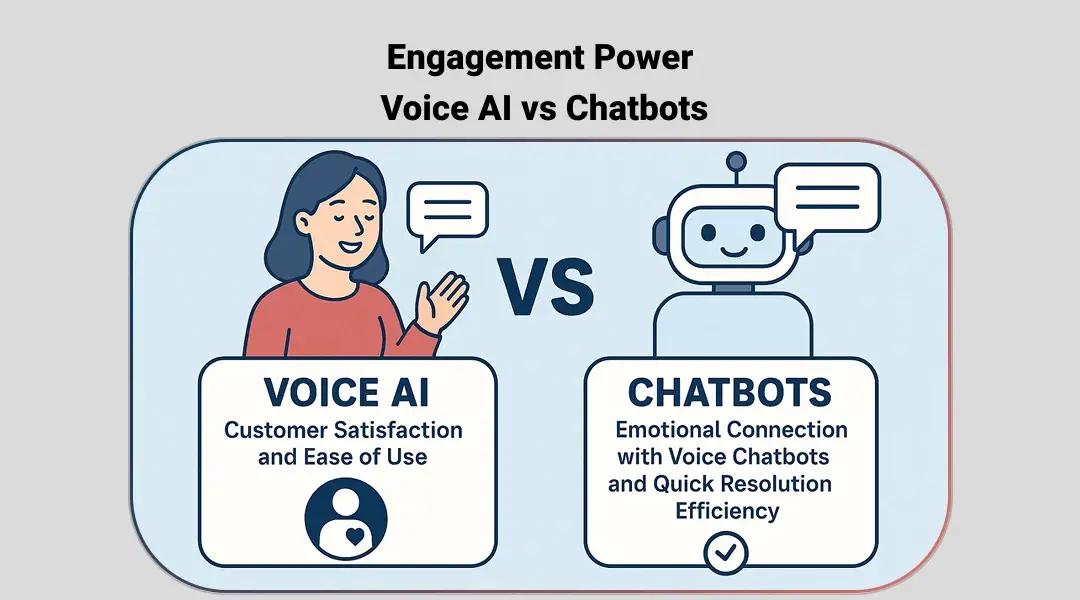Voice AI vs Chatbots: Which One Drives Better Engagement?
Let’s be honest: you’re probably tired of hearing vendors pitch Voice AI and Chatbots like they’re magic bullets. I get it. As someone who’s implemented both—sometimes with roaring success, sometimes with quiet embarrassment—I’ve learned a truth most sales decks won’t admit: the tool doesn’t drive engagement; the fit does.
In this article, I’ll break down Voice AI vs Chatbots, not as buzzwords, but as actual business solutions. By the end, you won’t just know the difference. You’ll know when to bet on one, when to use both, and how to avoid expensive missteps.
Why Businesses Are Rethinking Customer Engagement
Customer patience has collapsed. Nobody wants to wait on hold or scroll through FAQ pages. Businesses know this. That’s why conversational AI for customer support has become less of a “nice-to-have” and more of a survival tactic.
But here’s the catch: engagement isn’t about “automating conversations.” It’s about making people feel heard and helped—fast. And that’s where the battle of Voice AI vs Chatbots begins.
What is Voice AI?
Voice AI is essentially an AI voice agent—a system that understands, interprets, and responds to human speech. It’s powered by automatic speech recognition (ASR), natural language understanding (NLU), and synthetic speech.
Core Features
Real-time conversation (millisecond response times).
Multilingual capability.
Emotional tone detection.
Integration with CRMs, helpdesks, or call centers.
Examples in Business
Customer support hotlines: Banks using Voice AI for balance inquiries.
Sales: Retailers using AI voice assistants for product recommendations.
Healthcare: Appointment scheduling through AI voice agents.
This isn't a theory. I’ve personally overseen a retail project where Voice AI reduced average wait time by 47%.
What are Chatbots?
A chatbot is text-based software that simulates conversation. It’s often the first layer of customer interaction on websites and apps.
Types
Rule-based: Predefined scripts, decision trees. Low cost, but limited intelligence.
AI-driven: Powered by machine learning, can understand free-form queries, and adapt over time.
Common Use Cases
Lead generation: Capturing visitor info.
Customer service FAQs: “What’s my order status?”
Internal IT support: Automating password resets.
I once rolled out a rule-based chatbot for an e-commerce client. It handled 62% of queries in week one. Impressive on paper—until customers started asking nuanced questions. That’s where text bots hit their wall.
Voice AI vs Chatbots: Key Differences
Mode of Interaction
Voice AI = natural, fast, intuitive.
Chatbots = structured, controlled, easy to scale.
Complexity & Personalization
Voice AI can pick up tone and context, delivering more personalized engagement. Chatbots, unless advanced, often feel transactional.
Learning Capability & Scalability
AI-driven chatbots scale cheaply across platforms. Voice AI demands higher investment but pays off in high-touch industries.
Engagement Power: Voice AI vs Chatbots

Customer Satisfaction and Ease of Use
People speak 3x faster than they type. That alone makes Voice AI for customer engagement a winner in scenarios where speed matters.
Emotional Connection with Voice
Here’s something no metric captures well: humans bond with voices. An empathetic tone in a Voice AI system builds trust that a text chatbot never quite matches.
Chatbots and Quick Resolution Efficiency
That said, for chatbots in customer service, speed of resolution and 24/7 reliability make them indispensable. Customers tolerate transactional text better than they tolerate clunky voice interactions.
When to Use Voice AI
Healthcare & Banking: High-touch industries where trust and accuracy matter.
Multilingual Support: Voice AI shines in regions like India with diverse languages.
Accessibility: For customers who struggle with typing, voice-first is game-changing.
When to Use Chatbots
SMBs: Cost-effective automation with rule-based chatbots.
Quick FAQs: Shipping info, order status, appointment confirmations.
Lead Gen Funnels: Engage visitors without heavy setup.
Which Drives Better Engagement?
Let’s cut through the noise.
Voice AI customer experience shines when emotional connection and clarity are critical.
Chatbots for business automation dominate when efficiency and scale are the priority.
In practice? The highest engagement I’ve seen comes from hybrid approaches—a chatbot filters simple queries, then escalates to Voice AI for complex conversations.
And yes, I’ve seen the stats:
Chatbot engagement statistics show resolution rates as high as 80% for FAQs.
But when surveyed, customers reported Voice AI felt 2.5x more “human-like.”
Future of Conversational AI
This isn’t a competition to the death. The real future is AI-powered customer engagement tools that blend modalities. Picture a system where a chatbot handles FAQs, a voice agent jumps in for urgency, and both continuously learn.
That’s where conversational AI is heading. Not Voice vs Chatbot. But Voice + Chatbot.
Conclusion
So, Voice AI vs text chatbots—who wins? Neither. Both. It depends.
Voice AI builds emotional trust. Chatbots deliver efficient scale. Together, they’re not just tools; they’re the backbone of future customer engagement.
At KriraAI, I’ve seen companies waste thousands betting on the wrong fit. And I’ve seen businesses thrive when they design conversational AI around people first, tech second.
FAQs
It depends on context. Voice AI is better for emotional, high-touch scenarios. Chatbots work best for quick, transactional interactions.
Not entirely. Voice AI is powerful but expensive. Most companies benefit from a hybrid approach.
Chatbots in customer service handle FAQs, reduce response times, and cut costs while ensuring 24/7 availability.
Yes, in industries like healthcare or finance where trust matters. But for quick queries, chatbots still dominate.
Start by mapping customer needs. If emotional trust and multilingual access are priorities, consider Voice AI. If scale and cost matter more, start with chatbots.

CEO
